General
Wednesdays with Wade: Did the NAACP kill “Song of the South”?
Wade Sampson takes a close look at a little-known aspect of the history of this still controversial Disney Studio production: The time when the National Association for the Advancement of Colored People actually picketed this motion picture

This month is the 59th anniversary of the premiere of Disney’s still controversial “Song of the South.” Even though Disney has released the film in both Asian and European markets with no race riots occurring nor lengthy diatribes published condemning the film, the Walt Disney Company still hesitates to release the film in the United States. Despite the fact that — for many years now — there has been a healthy “blackmarket” selling bootleg copies to those who desperately want to see the film.
However, the story of why “Song of the South” is not available in the United States and the controversy sparked by its initial release is a saddening mixture of insensitivity, misunderstandings, and urban legends. It is a much more tangled web than many people realize.
Thanks to the extensive research work of Animation Historian Karl Cohen, whose book “Forbidden Animation” from McFarland Press devotes an entire chapter to the film’s release, and the historical article on the making of the film by Disney Historian Jim Korkis entitled “Who’s Afraid of the Song of the South?” that is scheduled to be printed early next year, I think I have enough understanding now to briefly discuss the connection of the NAACP in the controversy surrounding the film. I’d like to thank both those gentlemen for their groundbreaking research work.
It is important to remember that the “Song of the South” came out in 1946 and there was no balance of media images that featured the Huxtable family or John Shaft or George Jefferson or even Spike Lee. African-American performers often portrayed comic roles where they were characterized as lazy, slow-witted, easily scared, subserviant and worse.
Also remember that in 1946, the United States was a highly segregated country with separate facilities for non-whites. And that the brutal torture and lynching of African-Americans was so commonplace that the National Headquarters of the NAACP would fly a black flag out its window when news of a new lynching was confirmed.
The National Association for the Advancement of Colored People (NAACP) was officially formed on February 12, 1909 (timed to coincide with Abraham Lincoln’s one-hundredth birthday, although the name itself was not chosen until 1910). Appalled at the violence that was committed against African-American citizens including wide-spread lynchings as well as the “Jim Crow” laws that promoted racial discrimination and segregation, the organization contained both white and black members. In fact, white members held key positions on the board in the beginning.
One of its first protests against the portrayal of African-Americans in films was during the release of D.W. Griffith’s “Birth of a Nation” (1915) that the NAACP felt glamorized the birth of the Ku Klux Klan and sparked race riots across the country. Despite all its nationwide attempts to have the film banned, “Birth of the Nation” became a highly successful film and it is still widely available today as an example of innovations in filmmaking even while its racial slant is criticized.
Throughout the 1940s the NAACP saw enormous growth in its membership, claiming nearly 500,000 members by 1946. However, it wasn’t until 1948, that the NAACP was successful in pressuring President Harry Truman to sign an Executive Order banning discrimination by the Federal government.
When “Song of the South” was released, the NAACP was acting as a legislative and legal advocate, pushing unsuccessfully for a federal anti-lynching law and for an end to state-mandated segregation.
The NAACP attempted to create a “Hollywood Bureau” to convince Hollywood Studios to counter derogatory stereotypes of African Americans in motion pictures and to promote more realistic roles for black performers. There was extensive correspondence with producers such as David O. Selznick, Daryl F. Zanuck and other major studio moguls about such classic films as “Gone With the Wind,” “Ox Bow Incident,” “Pinky” and — of course — “Song of the South”.
The Disney Studio had come under close scrutiny when it first announced its work on the stories of Uncle Remus.
Reading the first drafts for the screenplay prepared by a Southern author named Dalton Reymond, who
| Advertisement
|
sprinkled the script with stereotypes and terms that were offensive when referring to African Americans, The Hays Office sent a warning to Disney. It was non-negotiable that those terms needed to be removed but that overall the film was acceptable in meeting the demands of the Production Code. However it strongly suggested “… again the advisability of your taking counsel with some responsible Negro authorities concerning the overall acceptability, from the standpoint of Negroes, of this story … Our Negro friends appear to be a bit critical of all motion picture stories which treat their people, and it may be that they will find in this story some material which may not be acceptable to them.”
Disney hired Clarence Muse in 1944. Clarence Edouard Muse was born in 1889. He was an African-American lawyer, writer, director, composer, and actor. After high school he earned a degree in International Law from The Dickinson School of Law of Pennsylvania in 1911. Disgusted with the poor opportunities for Black lawyers he then selected a show business career. Muse appeared as an opera singer, minstrel show performer, vaudeville and Broadway actor; he also wrote songs, plays, and sketches. He appeared in very dignified roles in films made for all Black audiences and was so articulate as to be considered a spokesman for the Black community.
Muse quit Disney early in 1944 after his ideas to portray the African American characters as more dignified and prosperous were rejected. Once Muse left Disney, he began to inform people about the nature of the Disney feature while it was still in the rough draft outline and before radical leftist screenwriter, Maurice Rapf had been brought in to make the script more acceptable. Muse wrote letters to the editors of black publications a that Disney was going to depict Negroes in an inferior capacity and that the film was “detrimental to the cultural advancement of the Negro people.” So the pump was already primed for disaster.
In later years, screenwriter Maurice Rapf remembered that Walt “had a theory that the reason why the film was picketed and particularly attacked by the Los Angeles chapter of the NAACP was because the head of the local chapter was actor Clarence Muse. He knew that Walt Disney wanted to do a Remus story, and Muse wanted to play Remus. He was a standard serious black actor, but Disney got someone else. Now others said that couldn’t be true, because Muse was a technical adviser on the film, though I think if that’s true he didn’t do a very good job advising.”
Both Walter White, the executive secretary of the NAACP at the time, and June Blythe, the director of the American Council on Race Relations, had requested to see a treatment of Disney’s “Song of the South” when the production was first announced. But they were ignored or politely given the run-around. Neither the NAACP nor the American Council on Race Relations had any opportunity to review the project before the press screening.
“Song of the South” had its premiere at Atlanta’s Fox Theater on November 12, 1946. The location was chosen to tie in with author Joel Chandler Harris who besides writing several books of the Uncle Remus stories was also a popular writer on the “Atlanta Constitution.”
However, “Song of the South’s” African American cast members were not able to join Walt Disney and the white cast members at the movie’s premiere in Atlanta, GA. because Atlanta was a segregated city. African Americans could not enter the movie theater or any other public buildings downtown. No hotel within reach of the theater would rent a room to James Baskett who portrayed Uncle Remus.
Walter White, the executive secretary of the NAACP, telegraphed major newspapers around the country with the following statement:
“The National Association for the Advancement of Colored People recognizes in ‘Song of the South’ remarkable artistic merit in the music and in the combination of living actors and the cartoon technique. It regrets, however, that in an effort neither to offend audiences in the north or south, the production helps to perpetuate a dangerously glorified picture of slavery. Making use of the beautiful Uncle Remus folklore, ‘Song of the South’ unfortunately gives the impression of an idyllic master-slave relationship which is a distortion of the facts.”
However, White had not yet seen the film and based his statement on memos sent to him by two NAACP staff members in New York who had attended a press screening on November 20, 1946. Norma Jensen wrote that the film was “so artistically beautiful that it is difficult to be provoked over the clichés” but that the film did contain “all the clichés in the book.” She did feel the Uncle Remus stories were commendable and she found “very touching” the relationship between the rich white boy and the black boy and white daughter of a tenant farmer but objected to scenes like the African Americans singing traditional songs since it was an offensive stereotype.
The other staff member, Hope Springarn, listed several objectionable images in the film, including the use of Negro dialect and the “Negroes singing outside the house” when the little white boy was dying.
Both Jensen and Springarn were also confused about the time of the story since it wasn’t clear that it was taking place during the Reconstruction and not during the Plantation days of slavery. It was something that also confused other reviewers who from the tone of the film and the type of similar recent Hollywood movies assumed it must also be set during the time of slavery.
So based on the information in those memos, White released the official position of the NAACP in that telegram that was widely quoted in newspapers including the December 4, 1946 issue of “Variety”, the trade journal of the motion picture industry.
Racially diverse groups of protesters organized to picket movie theaters in major American cities such as New York City, Los Angeles, San Francisco, and Boston. Yet the racial “harmony” demonstrated by these integrated groups of protesters was not common in most of the United States at the time and the philosophical make-up of these protestors resembled similar groups that protested and marched for civil rights in the Sixties. They were not so much protesting a particular incident or item but using that particular thing as a forum to protest a much larger injustice.
“We want films on Democracy not Slavery” and “Don’t prejudice children’s minds with films like this” were some of the slogans that decorated the signs of a racially diverse group of protesters who marched outside of the Paramount Theater in downtown Oakland, California. The protesters included African Americans and whites, men and women, old and young. The location of the protest was significant because in the 1940s, downtown Oakland was an elegant district with fancy hotels, expensive department stores, and several large-scale movie “palaces.”
At the film’s New York premiere in Times Square, dozens of black and white picketers, including African American servicemen recently returned from fighting in World War II, chanted:”We fought for Uncle Sam, not Uncle Tom.” While local chapters of the NAACP called for a total boycott of the film. And The National Negro Congress declared that the film “is an insult to the Negro people because it uses offensive dialect; it portrays the Negro as a low, inferior servant; it glorifies slavery” and called on Black people to “run the picture out of the area.”
The New York Tribune reported that at a press conference Walt Disney said that any real antagonism towards the film would come from radicals “who just love stirring up trouble whenever they can.” Disney defended it as a “monument to the Negro race,” pointing out that it was set after the Civil War and therefore could not be about slavery and “that the time had not yet come when Negro susceptibilities could be treated with as much delicacy as Hollywood reserves for, say, American Catholics.”
New York Times film reviewer Bosley Crowther wrote that the movie was a “travesty on the antebellum South…no matter how much one argues that it’s all childish fiction, anyhow, the master-and-slave relation is so lovingly regarded in your yarn, with the Negroes bowing and scraping and singing spirituals in the night that one might almost imagine that you figure Abe Lincoln made a mistake. Put down that mint julep, Mr. Disney.”
So did the NAACP kill Disney’s “Song of the South”? Not really, even though its initial criticism of the film may have been based on some faulty information. It did use the film as a rallying point that resulted in some changes in how films depicting African Americans were made.
Walt and the Disney Studio were not totally innocent either. The ambiguity of the story suggesting that all those happy, singing African Americans might indeed by slaves and Walt naively treating the film as another Disney fantasy (evident by those strong Mary Blair color stylings even in the live action scenes) rather than realizing that using real people would make people think it was all real added to the confusion and made defending the film more difficult than it should have been.
In a public interview, actor James Baskett who played Uncle Remus responded to the criticism by saying: “I believe that certain groups are doing my race more harm in seeking to create dissension than can ever possibly come out of the ‘Song of the South’.”
General
Seward Johnson bronzes add a surreal, artistic touch to NYC’s Garment District

Greetings from NYC. Nancy and I drove down from New
Hampshire yesterday because we'll be checking out
Disney Consumer Products' annual Holiday Showcase later today.
Anyway … After checking into our hotel (i.e., The Paul.
Which is located down in NYC's NoMad district), we decided to grab some dinner.
Which is how we wound up at the Melt Shop.

Photo by Jim Hill
Which is this restaurant that only sells grilled cheese sandwiches.
This comfort food was delicious, but kind of on the heavy side.

Photo by Jim Hill
Which is why — given that it was a beautiful summer night
— we'd then try and walk off our meals. We started our stroll down by the Empire
State Building
…
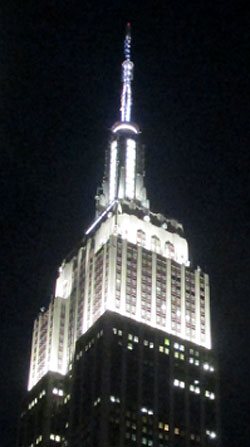
Photo by Jim Hill
… and eventually wound up just below Times
Square (right behind where the Waterford Crystal Times Square New
Year's Eve Ball is kept).

Photo by Jim Hill
But you know what we discovered en route? Right in the heart
of Manhattan's Garment District
along Broadway between 36th and 41st? This incredibly cool series of life-like
and life-sized sculptures that Seward
Johnson has created.

Photo by Jim Hill
And — yes — that is Abraham Lincoln (who seems to have
slipped out of WDW's Hall of Presidents when no one was looking and is now
leading tourists around Times Square). These 18 painted
bronze pieces (which were just installed late this past Sunday night / early
Monday morning) range from the surreal to the all-too-real.
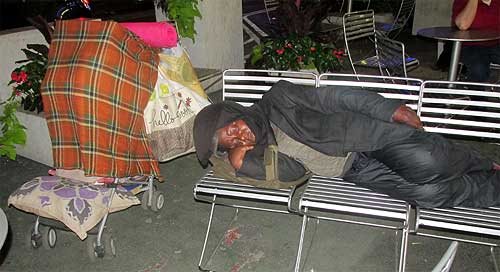
Photo by Jim Hill
Some of these pieces look like typical New Yorkers. Like the
business woman planning out her day …

Photo by Jim Hill
… the postman delivering the mail …

Photo by Jim Hill
… the hot dog vendor working at his cart …

Photo by Jim Hill
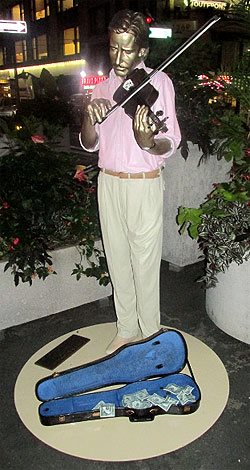
Photo by Jim Hill
… the street musician playing for tourists …

Photo by Jim Hill
Not to mention the tourists themselves.
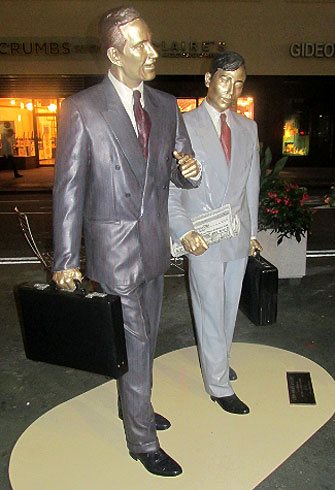
Photo by Jim Hill
But right alongside the bronze businessmen …

Photo by Jim Hill
… and the tired grandmother hauling her groceries home …
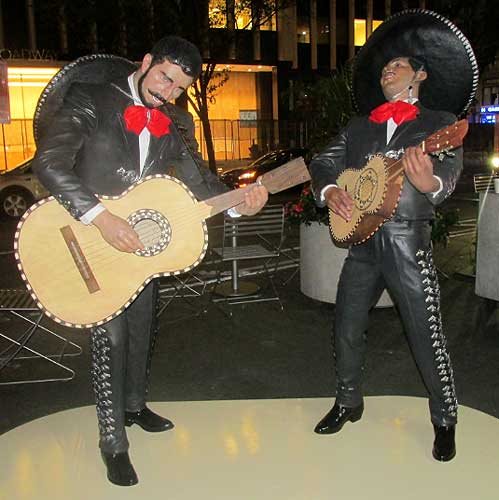
Photo by Jim Hill
… there were also statues representing people who were
from out-of-town …

Photo by Jim Hill
… or — for that matter — out-of-time.

Photo by Jim Hill
These were the Seward Johnson pieces that genuinely beguiled. Famous impressionist paintings brought to life in three dimensions.

Note the out-of-period water bottle that some tourist left
behind. Photo by Jim Hill
Some of them so lifelike that you actually had to pause for
a moment (especially as day gave way to night in the city) and say to yourself
"Is that one of the bronzes? Or just someone pretending to be one of these
bronzes?"
Mind you, for those of you who aren't big fans of the
impressionists …

Photo by Jim Hill
… there's also an array of American icons. Among them
Marilyn Monroe …
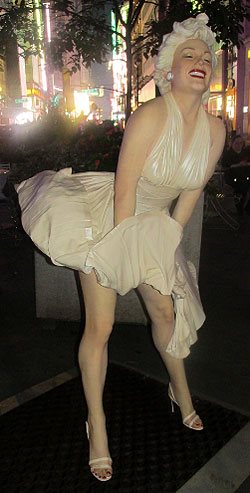
Photo by Jim Hill
… and that farmer couple from Grant Wood's "American
Gothic."

Photo by Jim Hill
But for those of you who know your NYC history, it's hard to
beat that piece which recreates Alfred Eisenstaedt's famous photograph of V-J Day in Times Square.

Photo by Jim Hill
By the way, a 25-foot-tall version of this particular Seward
Johnson piece ( which — FYI — is entitled "Embracing Peace") will actually
be placed in Times Square for a few days on or around August 14th to commemorate the 70th
anniversary of Victory Over Japan Day (V-J Day).

Photo by Jim Hill
By the way, if you'd like to check these Seward Johnson bronzes in
person (which — it should be noted — are part of the part of the Garment
District Alliance's new public art offering) — you'd best schedule a trip to
the City sometime over the next three months. For these pieces will only be on
display now through September 15th.
General
Wondering what you should “Boldly Go” see at the movies next year? The 2015 Licensing Expo offers you some clues

Greeting from the 2015 Licensing Expo, which is being held
at the Mandalay Bay
Convention Center in Las
Vegas.

Photo by Jim Hill
I have to admit that I enjoy covering the Licensing Expo.
Mostly becomes it allows bloggers & entertainment writers like myself to
get a peek over the horizon. Scope out some of the major motion pictures &
TV shows that today's vertically integrated entertainment conglomerates
(Remember when these companies used to be called movie studios?) will be
sending our way over the next two years or so.
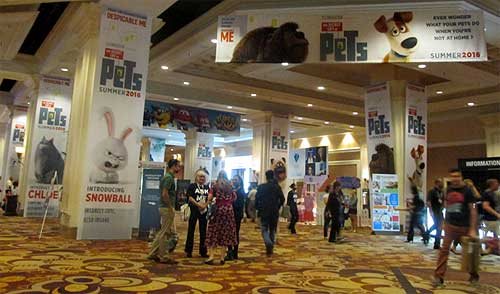
Photo by Jim Hill
Take — for example — all of "The Secret Life of
Pets" banners that greeted Expo attendees as they made their way to the
show floor today. I actually got to see some footage from this new Illumination
Entertainment production (which will hit theaters on July 8, 2016) the last time I was in Vegas. Which
was for CinemaCon back in April. And the five or so minutes of film that I viewed
suggested that "The Secret Life of Pets" will be a really funny
animated feature.

Photo by Jim Hill
Mind you, Universal Pictures wanted to make sure that Expo
attendees remembered that there was another Illumination Entertainment production
coming-to-a-theater-near-them before "The Secret Life of Pets" (And
that's "Minions," the "Despicable Me" prequel. Which
premieres at the Annecy International Animated Film Festival next week but
won't be screened stateside 'til July 10th of this year). Which is why they had
three minions who were made entirely out of LEGOS loitering out in the lobby.

Photo by Jim Hill
And Warner Bros. — because they wanted "Batman v
Superman: Dawn of Justice" to start trending on Twitter today — brought
the Batmobile to Las Vegas.
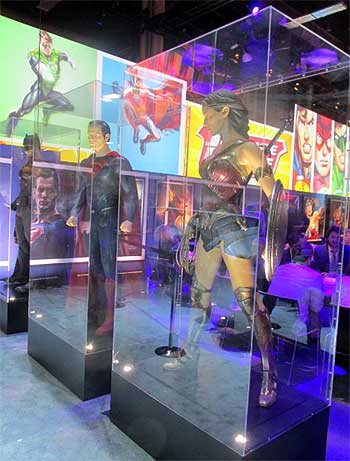
Photo by Jim Hill
Not to mention full-sized macquettes of Batman, Superman and
Wonder Woman. Just so conventioneers could then see what these DC superheroes
would actually look like in this eagerly anticipated, March 25, 2016 release.

Photo by Jim Hill
That's the thing that can sometimes be a wee bit frustrating
about the Licensing Expo. It's all about delayed gratification. You'll come
around a corner and see this 100 foot-long ad for "The Peanuts Movie"
and think "Hey, that looks great. I want to see that Blue Sky Studios production
right now." It's only then that you notice the fine print and realize that
"The Peanuts Movie" doesn't actually open in theaters 'til November
6th of this year.

Photo by Jim Hill
And fan of Blue Sky's "Ice Age" film franchise are in for an even
longer wait. Given that the latest installment in that top grossing series
doesn't arrive in theaters 'til July
15, 2016.

Photo by Jim Hill
Of course, if you're one of those people who needs immediate
gratification when it comes to your entertainment, there was stuff like that to
be found at this year's Licensing Expo. Take — for example — how the WWE
booth was actually shaped like a wrestling ring. Which — I'm guessing — meant
that if the executives of World Wrestling Entertainment, Inc. didn't like
the offer that you were making, they were then allowed to toss you out over the
top rope, Royal Rumble-style.

Photo by Jim Hill
I also have to admit that — as a longtime Star Trek fan —
it was cool to see the enormous Starship Enterprise that hung in place over the
CBS booth. Not to mention getting a glimpse of the official Star Trek 50th
Anniversary logo.
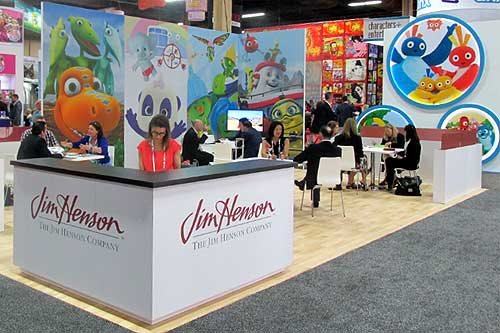
Photo by Jim Hill
I was also pleased to see lots of activity in The Jim Henson
Company booth. Which suggests that JHC has actually finally carved out a
post-Muppets identity for itself.

Photo by Jim Hill
Likewise for all of us who were getting a little concerned
about DreamWorks Animation (what with all the layoffs & write-downs &
projects that were put into turnaround or outright cancelled last year), it was
nice to see that booth bustling.

Photo by Jim Hill
Every so often, you'd come across some people who were
promoting a movie that you weren't entirely sure that you actually wanted to
see (EX: "Angry Birds," which Sony Pictures Entertainment / Columbia
Pictures will be releasing to theaters on May 20, 2016). But then you remembered that Clay Kaytis —
who's this hugely talented former Walt Disney Animation Studios animator — is
riding herd on "Angry Birds" with Fergal Reilly. And you'd think
"Well, if Clay's working on 'Angry Birds,' I'm sure this animated feature
will turn out fine."

Photo by Jim Hill
Mind you, there were reminders at this year's Licensing Expo
of great animated features that we're never going to get to see now. I still
can't believe — especially after that brilliant proof-of-concept footage
popped up online last year — that Sony execs decided not to go forward
with production of Genndy Tartakovsky's
"Popeye" movie. But that's the
cruel thing about the entertainment business, folks. It will sometime break
your heart.
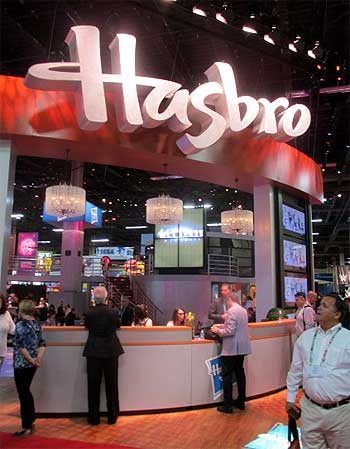
Photo by Jim Hill
And make no mistake about this. The Licensing Expo is all
about business. That point was clearly driven home at this year's show when —
as you walked through the doors of the Mandalay
Bay Convention Center
— the first thing that you saw was the Hasbros Booth. Which was this gleaming,
sleek two story-tall affair full of people who were negotiating deals &
signing contracts for all of the would-be summer blockbusters that have already
announced release dates for 2019 & beyond.

Photo by Jim Hill
"But what about The Walt Disney Company?," you
ask. "Weren't they represented on the show floor at this year's Licensing
Expo?" Not really, not. I mean, sure. There were a few companies there hyping
Disney-related products. Take — for example — the Disney Wikkeez people.
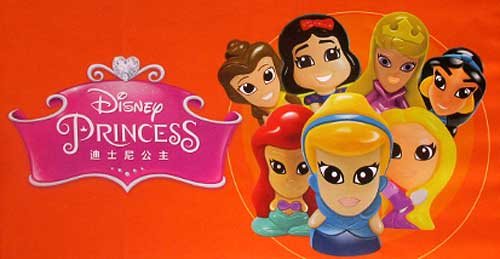
Photo by Jim Hill
I'm assuming that some Disney Consumer Products exec is
hoping that Wikkeez will eventually become the new Tsum Tsum. But to be blunt,
these little hard plastic figures don't seem to have the same huggable charm
that those stackable plush do. But I've been wrong before. So let's see what
happens with Disney Wikkeez once they start showing up on the shelves of the
Company's North American retail partners.

Photo by Jim Hill
And speaking of Disney's retail partners … They were
meeting with Mouse House executives behind closed doors one floor down from the
official show floor for this year's Licensing Expo.

Photo by Jim Hill
And the theme for this year's invitation-only Disney shindig? "Timeless
Stories" involving the Disney, Pixar, Marvel & Lucasfilm brands that
would then appeal to "tomorrow's consumer."

Photo by Jim Hill
And just to sort of hammer home the idea that Disney is no
longer the Company which cornered the market when it comes to little girls
(i.e., its Disney Princess and Disney Fairies franchises), check out this
wall-sized Star Wars-related image that DCP put up just outside of one of its
many private meeting rooms. "See?," this carefully crafted photo
screams. "It isn't just little boys who want to wield the Force. Little
girls also want to grow up and be Lords of the Sith."
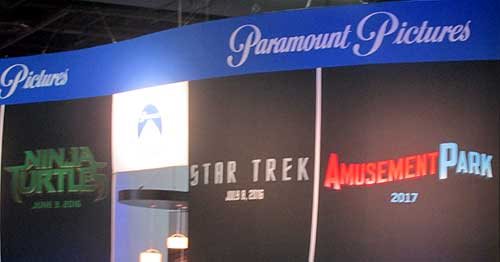
Photo by Jim Hill
One final, kind-of-ironic note: According to this banner,
Paramount Pictures will be releasing a movie called "Amusement Park"
to theaters sometime in 2017.

Photo by Jim Hill
Well, given all the "Blackfish" -related issues
that have been dogged SeaWorld Parks & Entertainment over the past two years, I'm
just hoping that they'll still be in the amusement park business come 2017.
Your thoughts?
General
It takes more than three circles to craft a Classic version of Mickey Mouse

You know what Mickey Mouse looks like, right? Little guy,
big ears?
Truth be told, Disney's corporate symbol has a lot of
different looks. If Mickey's interacting with Guests at Disneyland
Park (especially this summer, when
the Happiest Place on Earth
is celebrating its 60th anniversary), he looks & dresses like this.
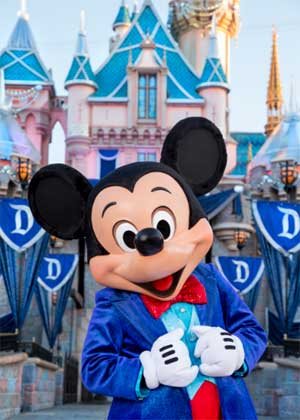
Copyright Disney Enterprises,
Inc.
All rights reserved
Or when he's appearing in one of those Emmy Award-winning shorts that Disney
Television Animation has produced (EX: "Bronco Busted," which debuts
on the Disney Channel tonight at 8 p.m. ET / PT), Mickey is drawn in a such a
way that he looks hip, cool, edgy & retro all at the same time.
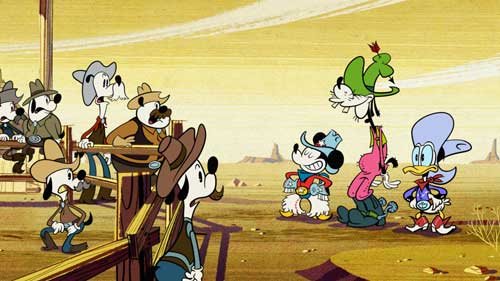
Copyright Disney Enterprises, Inc. All rights
reserved
Looking ahead to 2017 now, when Disney Junior rolls out "Mickey and the
Roadster Racers," this brand-new animated series will feature a sportier version
of Disney's corporate symbol. One that Mouse House managers hope will persuade
preschool boys to more fully embrace this now 86 year-old character.

Copyright Disney Enterprises,
Inc. All rights reserved
That's what most people don't realize about the Mouse. The
Walt Disney Company deliberately tailors Mickey's look, even his style of
movement, depending on what sort of project / production he's appearing in.
Take — for example — Disney
California Adventure
Park's "World of Color:
Celebrate!" Because Disney's main mouse would be co-hosting this new
nighttime lagoon show with ace emcee Neil Patrick Harris, Eric Goldberg really had
to step up Mickey's game. Which is why this master Disney animator created
several minutes of all-new Mouse animation which then showed that Mickey was
just as skilled a showman as Neil was.

Copyright Disney Enterprises,
Inc.
All rights reserved
Better yet, let's take a look at what the folks at Avalanche Studios just went
through as they attempted to create a Classic version of Mickey & Minnie.
One that would then allow this popular pair to become part of Disney Infinity
3.0.
"I won't lie to you. We were under a lot of pressure to
get the look of this particular version of Mickey — he's called Red Pants
Mickey around here — just right," said Jeff Bunker, the VP of Art
Development at Avalanche Studios, during a recent phone interview. "When
we brought Sorcerer Mickey into Disney Infinity 1.0 back in January of 2014,
that one was relatively easy because … Well, everyone knows what Mickey Mouse
looked like when he appeared in 'Fantasia.' "

Copyright Disney Enterprises,
Inc. All rights reserved
"But this time around, we were being asked to design
THE Mickey & Minnie," Bunker continued. "And given that these Classic
Disney characters have been around in various different forms for the better
part of the last century … Well, which look was the right look?"
Which is why Jeff and his team at Avalanche Studios began watching hours &
hours of Mickey Mouse shorts. As they tried to get a handle on which look would
work best for these characters in Disney Infinity 3.0.

Copyright Disney
Enterprises, Inc. All rights reserved
"And we went all the way back to the very start of Mickey's career. We began
with 'Steamboat Willie' and then watched all of those black & white Mickey shorts
that Walt made back in the late 1920s & early 1930s. From there, we
transitioned to his Technicolor shorts. Which is when Mickey went from being
this pie-eyed, really feisty character to more of a well-behaved leading
man," Bunker recalled. "We then finished out our Mouse marathon by
watching all of those new Mickey shorts that Paul Rudish & his team have
been creating for Disney Television Animation. Those cartoons really recapture
a lot of the spirit and wild slapstick fun that Mickey's early, black &
white shorts had."
But given that the specific assignment that Avalanche Studios had been handed
was to create the most appealing looking, likeable version of Mickey Mouse
possible … In the end, Jeff and his team wound up borrowing bits & pieces
from a lot of different versions of the world's most famous mouse. So that
Classic Mickey would then look & move in a way that best fit the sort of
gameplay which people would soon be able to experience with Disney Infinity
3.0.

Copyright Disney Enterprises,
Inc. All rights reserved
"That — in a lot of ways — was actually the toughest
part of the Classic Mickey design project. You have to remember that one of the
key creative conceits of Disney Infinity
is that all the characters which appear in this game are toys," Bunker
stated. "Okay. So they're beautifully detailed, highly stylized toy
versions of beloved Disney, Pixar, Marvel & Lucasfilm characters. But
they're still supposed to be toys. So our Classic versions of Mickey &
Minnie have the same sort of thickness & sturdiness to them that toys have.
So that they'll then be able to fit right in with all of the rest of the
characters that Avalanche Studios had previously designed for Disney Infinity."
And then there was the matter of coming up with just the
right pose for Classic Mickey & Minnie. Which — to hear Jeff tell the
story — involved input from a lot of Disney upper management.
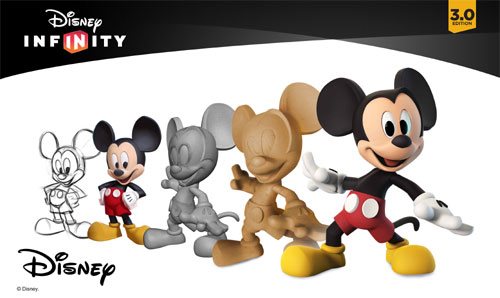
Copyright Disney Enterprises,
Inc. All rights reserved
"Everyone within the Company seemed to have an opinion
about how Mickey & Minnie should be posed. More to the point, if you Google
Mickey, you then discover that there are literally thousands of poses out there
for these two. Though — truth be told — a lot of those kind of play off the
way Mickey poses when he's being Disney's corporate symbol," Bunker said.
"But what I was most concerned about was that Mickey's pose had to work
with Minnie's pose. Because we were bringing the Classic versions of these
characters up into Disney Infinity 3.0 at the exact same time. And we wanted to
make sure — especially for those fans who like to put their Disney Infinity
figures on display — that Mickey's pose would then complement Minnie.
Which is why Jeff & the crew at Avalanche Studios
decided — when it came to Classic Mickey & Minnie's pose — that they
should go all the way back to the beginning. Which is why these two Disney icons
are sculpted in such a way that it almost seems as though you're witnessing the
very first time Mickey set eyes on Minnie.

Copyright Disney Enterprises,
Inc. All rights reserved
"And what was really great about that was — as soon as
we began showing people within the Company this pose — everyone at Disney
quickly got on board with the idea. I mean, the Classic Mickey that we sculpted
for Disney Infinity 3.0 is clearly a very playful, spunky character. But at the
same time, he's obviously got eyes for Minnie," Bunker concluded. "So
in the end, we were able to come up with Classic versions of these characters
that will work well within the creative confines of Disney Infinity 3.0 but at
the same time please those Disney fans who just collect these figures because
they like the way the Disney Infinity characters look."
So now that this particular design project is over, does
Jeff regret that Mouse House upper management was so hands-on when it came to
making sure that the Classic versions of Mickey & Minnie were specifically
tailored to fit the look & style of gameplay found in Disney Infinity 3.0?
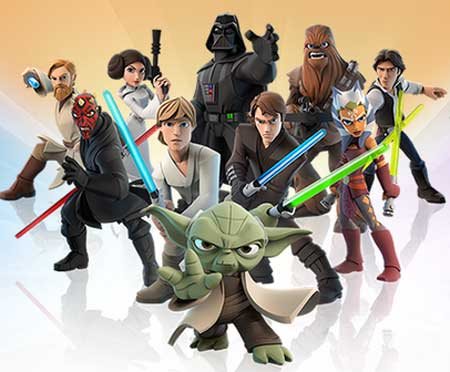
Copyright Lucasfilm / Disney
Enterprises, Inc. All rights reserved
"To be blunt, we go through this every time we add a new character to the
game. The folks at Lucasfilm were just as hands-on when we were designing the
versions of Darth Vader and Yoda that will also soon be appearing in Disney
Infinity 3.0," Bunker laughed. "So in the end, if the character's
creators AND the fans are happy, then I'm happy."
This article was originally posted on the Huffington Post's Entertainment page on Tuesday, June 9, 2015
-

 Film & Movies7 months ago
Film & Movies7 months agoBefore He Was 626: The Surprisingly Dark Origins of Disney’s Stitch
-

 History5 months ago
History5 months agoCalifornia Misadventure
-

 History10 months ago
History10 months agoThe Super Bowl & Disney: The Untold Story Behind ‘I’m Going to Disneyland!’
-

 Television & Shows11 months ago
Television & Shows11 months agoHow the Creators of South Park Tricked A-List Celebrities to Roast Universal – “Your Studio & You”
-

 Film & Movies6 months ago
Film & Movies6 months agoThe Best Disney Animation Film Never Made – “Chanticleer”
-

 Theme Parks & Themed Entertainment5 months ago
Theme Parks & Themed Entertainment5 months agoThe ExtraTERRORestrial Files
-

 History6 months ago
History6 months agoWhy Disney’s Animal Kingdom’s Beastly Kingdom Was Never Built
-

 Television & Shows8 months ago
Television & Shows8 months agoThe Untold Story of Super Soap Weekend at Disney-MGM Studios: How Daytime TV Took Over the Parks







